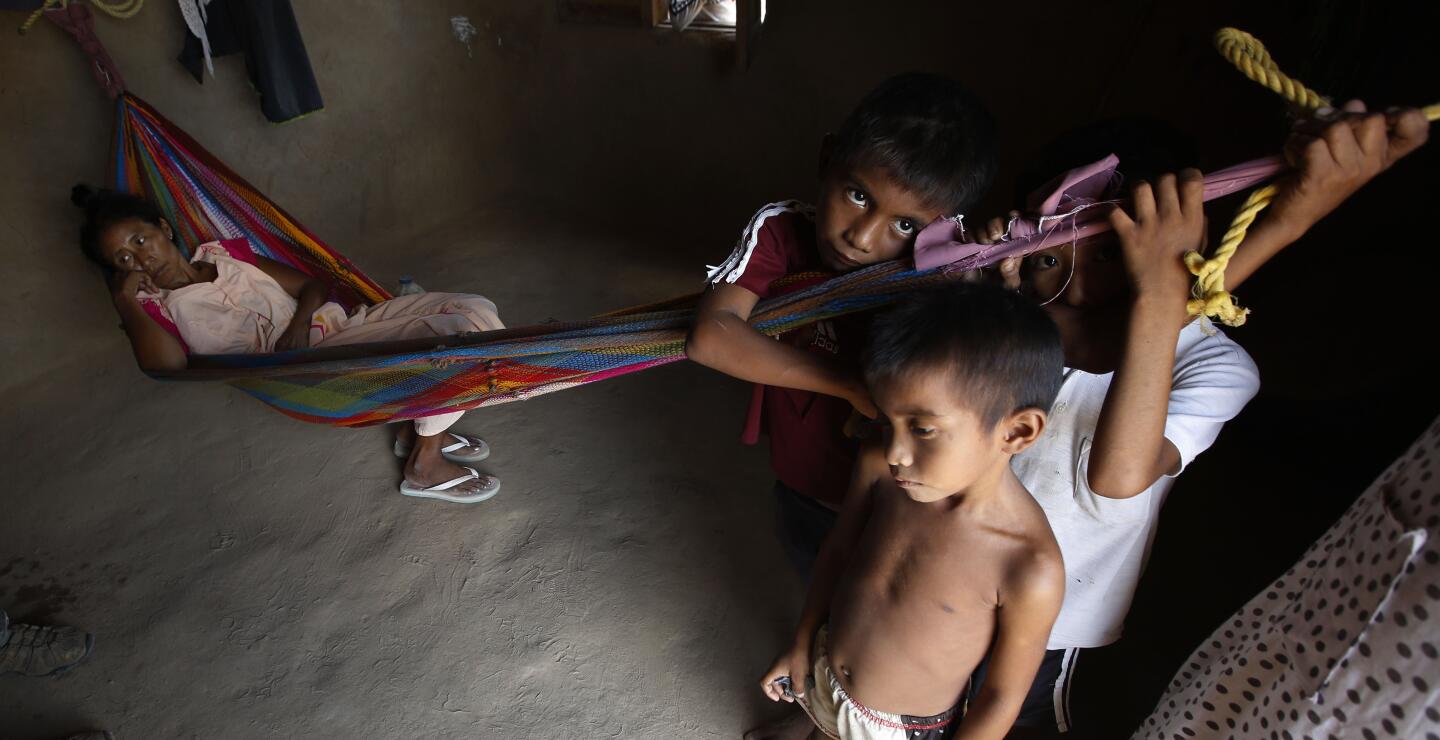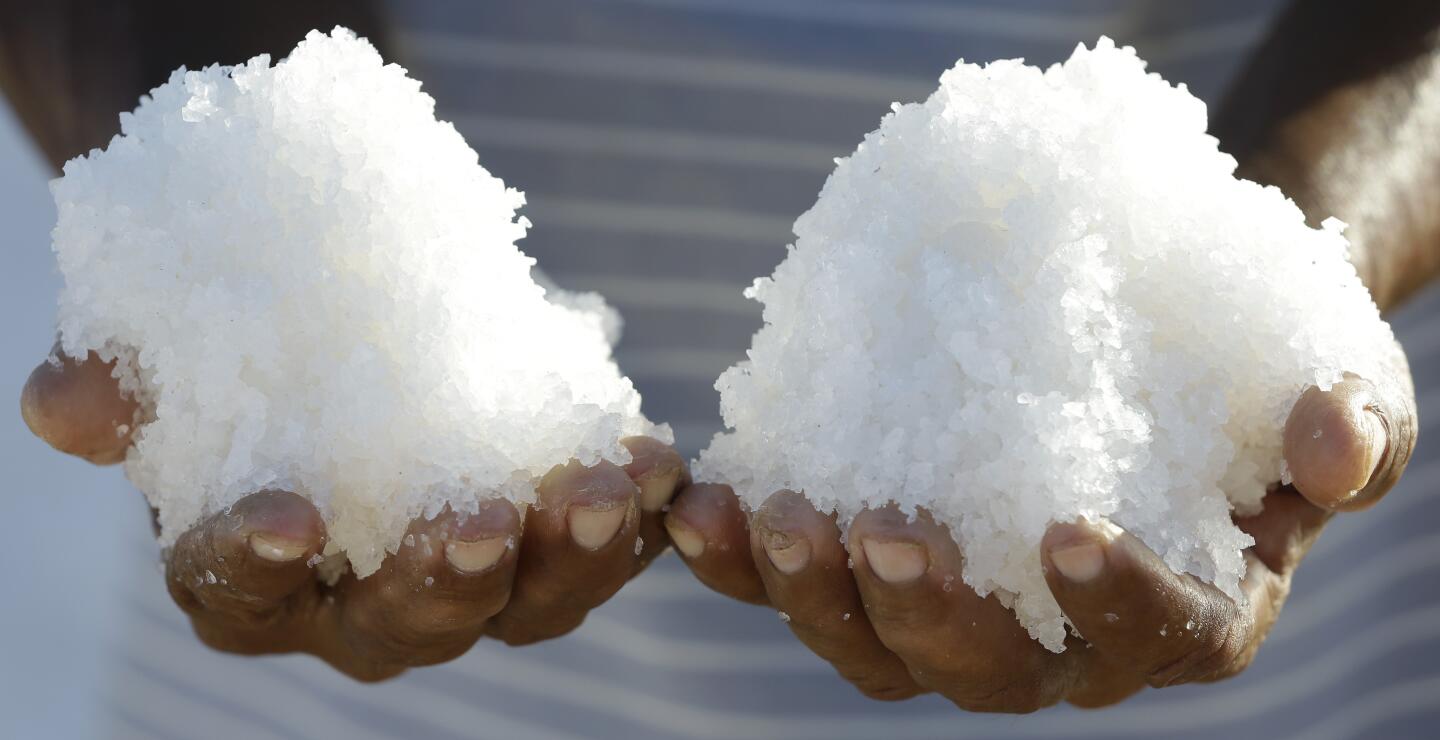
Gladis Fatima Castro rests in her hammock inside her dirt floor home in Manaure, Colombia, Thursday, Sept. 10, 2015. Three days ago she lost her 14-year-old daughter and a doctors certificate shows the diagnosis: severe malnutrition that led first to hair loss and then sores in her mouth that prevented her from swallowing the vitamins and minerals doctors prescribed. I didnt have enough even to pay for them, said Fatima, who has two remaining younger children. (AP Photo/Fernando Vergara)
Fernando Vergara/AP

Wayuu indigenous children stand in the shade of their adobe home in Manaure, Colombia, Thursday, Sept. 10, 2015. Hunger exacerbated by a two-year-old drought is one of the biggest problems facing the Wayuu, a 600,000-strong ancestral tribe thats caught in the middle of Venezuelas crackdown on smuggling along its western border with Colombia. (AP Photo/Fernando Vergara)
Fernando Vergara/AP

A Wayuu indigenous man rests in a hammock in Manaure, Colombia, Thursday, Sept. 10, 2015. The desert tribe doesn't carry passports nor do they recognize international borders. (AP Photo/Fernando Vergara)
Fernando Vergara/AP

In this Sept. 9, 2015 photo, Wayuu indigenous women walk along a dirt street in their community of Albania, Colombia. The Wayuu for centuries have dominated life on La Guajira peninsula, the northernmost tip of South America, first resisting conquest by Spain and since independence freely crossing the Colombian-Venezuelan border that arbitrarily divides clans in their ancestral homeland. (AP Photo/Fernando Vergara)
Fernando Vergara/AP

Mugs hang to dry on a fence outside the home of a Wayuu indigenous family in Manaure, Colombia, Thursday, Sept. 10, 2015. The majority of Colombias Wayuu live in poverty. La Guajira peninsula, the northernmost tip of South America, has the highest malnutrition rate in Colombia, at 11 percent, according to the public defender's office. (AP Photo/Fernando Vergara)
Fernando Vergara/AP

In this Sept. 9, 2015 photo, a Wayuu indigenous woman attends a community meeting in Albania, Colombia. Community meetings are held by the adult men and women of the community when specific problems arise that need to be resolved. (AP Photo/Fernando Vergara)
Fernando Vergara/AP

In this Sept. 9, 2015 photo, Wayuu indigenous women attend a community meeting in Albania, Colombia. Women are responsible for preserving the groups traditions and ethnic lineage. (AP Photo/Fernando Vergara)
Fernando Vergara/AP

Wayuu indigenous boys play in a tree in Manaure, Colombia, Thursday, Sept. 10, 2015. Hunger exacerbated by a two-year-old drought is one of the biggest problems facing the Wayuu, a 600,000-strong ancestral tribe in La Guajira peninsula, the northernmost tip of South America. (AP Photo/Fernando Vergara)
Fernando Vergara/AP

In this Sept. 9, 2015 photo, Wayuu indigenous man Eusebio Epieyu works shoveling sea salt until sunset in Manaure, Colombia. Its a poorly-paid profession but one that provides sustenance to many. Workers make about .30 cents for each sack of salt. (AP Photo/Fernando Vergara)
Fernando Vergara/AP

In this Sept. 9, 2015 photo, a Wayuu indigenous man shows handfuls of sea salt collected manually in Manaure, Colombia. For centuries, the Wayuu have gotten by in this desolate, desert-like landscape shoveling salt under an intense 40 degrees Celsius heat. (AP Photo/Fernando Vergara)
Fernando Vergara/AP

Wayuu indigenous children play in Manaure, Colombia, Thursday, Sept. 10, 2015. La Guajira peninsula has the highest malnutrition rate in Colombia, at 11 percent, according to the public defender's office. (AP Photo/Fernando Vergara)
Fernando Vergara/AP

In this Sept. 9, 2015 photo, a Wayuu indigenous man carries a sack of sea salt in Manaure, Colombia. For centuries, the Wayuu have gotten by in this desolate, desert-like landscape shoveling salt into large piles under an intense 40 degrees Celsius heat. Workers make about .30 cents per sack. (AP Photo/Fernando Vergara)
Fernando Vergara/AP


